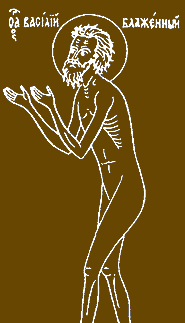MIDTERM QUESTION B
Discuss the concept of asceticism. What are its forms, goals, values? Is asceticism a uniform phenomenon?
#1
Asceticism is an exotic term in today`s world. Two months ago I thought it referred only to Indian practices, but that is more than my roommate, who did not even know how to pronounce the word. This is all unfortunate because asceticism might be the answer we, as humanity, need to explore as we are becoming spiritually weakened by our all-encompassing consumer culture. Whereas consumerism, especially marketing, is based on instilling fear, "asceticism frees us in particular from fear" (Course Packet [CP] 86). As modern man sometimes rejects consumerism in an attempt to regain his freedom, so, too, did the man of antiquity reject social structures that tried to limit his freedom.
There were several forms of asceticism. A major distinction between groups of ascetics has been positive, or natural, asceticism versus negative, or unnatural, asceticism; the differences have been explored by Kallistos Ware in the first chapter of his book, Asceticism, "The Way of the Ascetics: Negative or Affirmative?" Some say that ?what basically distinguishes natural from unnatural asceticism is its attitude toward the body? (CP 89). While the way of asceticism is founded on extreme self-discipline and denial of worldly pleasures, negative asceticism goes beyond mere rejection. The negative involved seeking out means to cause pain and do harm to the body. So although its practitioners might have argued that through their physical suffering they achieved higher spiritual states, they were deemed heretics because their practices showed `distinct hatred for God`s creation` (CP 90). For example, unnatural asceticism would entail castration while the natural way is to simply abstain from sex and marriage. Thus, the natural, or world-affirming, ascetics sought to live a simple way. The Russian priest Alexander Elchaninov stressed that the `important element . . . is not the fact of abstaining from this or that, or of depriving oneself of something by way of punishment,` but "refinement" of our physical being; it is through this refinement that we become open to greater, spiritual forces (CP 90). To summarize, asceticism is "a system of exercises which submits the body to the spirit" (CP 90).
Another distinction between ascetics was the hermits and those who lived in communities. While many of the hermits, or anchorites, were romanticized and gained fame for their exploits, notably in the Egyptian desert, the cenobites, who lived in communities, provided a more accessible alternative to those who wanted to be closer to God. The cenobites, while not as respected as the anchorites, have provided the basis for many of today`s monasteries and kept asceticism in the social realm, so to speak. Elizabeth Clark writes, "Although hagiographic literature stresses the separation of the ascetic from "the world," other evidence . . . suggests that ascetics were often more connected to it than we at first might imagine" (CP 105). This tradition provided, in essence, a regulating body on the Church, which throughout history has tried to separate its members from the populace.
Thus, asceticism existed in many parts of the Christian world. From Syria to Italy and from Egypt to Cyprus, Ascetics lived and practiced. This, by no means, constitutes a world phenomenon, but it was a fairly prevalent movement in the early Christian world. And why not? Through its self-improving discipline, it gave laypeople the opportunity to "cultivate extraordinary forms of human existence" (CP 95).
#2
The term asceticism comes from the Greek word for training, both of the mind and of the body. Asceticism was not a uniform phenomenon. It had a number of different forms though many practices, such as living simply and fasting, as well as the goal of remained almost universally the same. The goal of asceticism was to become closer to God. Greek ascetics attempted to do so by becoming more virtuous while Christian ascetics, usually monks and nuns, tried to approach God via virtue and prayer.
Epictetus, born in 55 AD, asked himself the questions: Why is man happy or unhappy? What makes man happy or unhappy? To answer these questions he sought out the root of human suffering, which he felt was a combination of desires and the uncontrolled mind. He concluded that while the outside world may not be controlled and tragedies and misfortunes are going to happen, people can train themselves to not let such things affect them by preparing themselves. Epictetus devised self-help techniques to train the mind. Integral to his methods was meditation, which was the key to maintaining peace of mind. One of the goals of Epictetus? program was to be able to divorce oneself from emotions. This ability is valued by nearly all the schools of asceticism.
Diogenes will serve as the principle example for Greek asceticism. An offspring of Socratic tradition, Diogenes sought to live a very simple life, one which stressed non-possession. He wore only a simple cloak and carried a staff and his wallet. His wallet contained virtually everything that he owned since he was homeless. Throughout his life, the number of his possessions decreased as he threw away his cup when he saw a little boy drinking from his hands and his plate after he saw a boy using a loaf of bread as a substitute. Kallistos Ware, a high ranking official in the Greek Orthodox Church, said that ascetics wanted to detach themselves from everything because any possession you have can be taken away. If one has nothing, there is nothing for one to fear losing.
Diogenes considered himself a citizen of the world, which, meant that he was a citizen of no one place. As such, he disassociated himself from any and all political and social structures, considering the only authority to be God. This idea of withdrawal from society became a common ascetic practice in both Egypt and Syria, though Christian ascetics in these locations took the disassociation to another level. Many ascetics moved to the desert to avoid the worldly temptations of the cities. In effect, they chose to subject themselves to the possibilities of death via attacks by wild animals or wandering tribes of dangerous people, along with a chance of starving, rather than living with the evils in the city because, above all else, they wanted to be closer to God - no matter the risk. There were a number of monasteries where monks would congregate. They would sit alone in their individual cells and pray. Sometimes they wove baskets to help pay for the small amount of food they allowed themselves to eat during their fasting. Syrian ascetics engaged in a number of strange practices. From self-mutilation to living in extremely spaces with very limited resources, Syrian ascetics experimented to see just how far the human body could be pushed before it was no longer possible to live. Still others, sometimes called ?grazers,? attempted to live outside the city with the wild animals. They did all this as they attempted to remain in constant prayer.
While the Greek ascetics tried to approach God only by acquiring virtue, Christian ascetics devoted themselves to both virtue and prayer. As can be seen in these various examples, asceticism may be practiced in a number of different ways but the ultimate goal is still to become closer to God.







